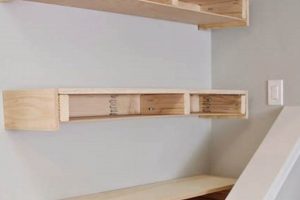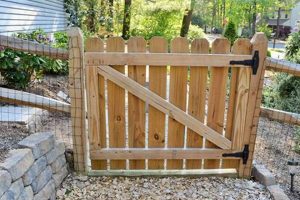Handcrafted table settings, created from individual initiative and skill, are a decorative and functional addition to any dining environment. These personalized pieces serve to protect table surfaces from heat and spills, while also contributing to the aesthetic appeal of the meal presentation.
The advantages of constructing these items include cost savings, opportunities for creative expression, and the satisfaction of producing a useful object. Historically, resourceful individuals have fashioned similar items from available materials, showcasing both practicality and artistic flair. Their creation allows for personalized dcor that reflects individual taste and complements existing tableware.
The following sections will explore various materials, techniques, and design considerations relevant to the construction of these personalized table accessories, offering a guide to achieve both visually appealing and durable results.
Construction Tips for Customized Table Settings
The following are guidelines for crafting individualized table accessories, designed to enhance both function and visual appeal.
Tip 1: Material Selection. Appropriate fabrics and materials are crucial. Durable options include cotton canvas, linen blends, and heat-resistant cork. The chosen material should withstand repeated use and cleaning.
Tip 2: Precision Cutting. Accurate measurements and precise cutting are essential for a uniform and professional appearance. Utilize a rotary cutter, cutting mat, and ruler for best results. Ensure all pieces are the same size and shape.
Tip 3: Edge Finishing. Properly finishing the edges prevents fraying and extends the lifespan of the creation. Options include serging, binding with bias tape, or folding and hemming. Selection should be based on fabric type and desired aesthetic.
Tip 4: Heat Resistance. If hot dishes will be placed directly on the finished product, incorporate a heat-resistant layer. Consider using Insul-Bright batting or a similar specialized material within the construction.
Tip 5: Secure Construction. Use a strong, durable thread and a consistent stitch length during assembly. Reinforce corners and high-stress areas to prevent seam separation during use and washing.
Tip 6: Design Considerations. The pattern and color scheme should complement the existing dining area and tableware. Consider incorporating contrasting fabrics or decorative stitching to add visual interest.
Tip 7: Waterproofing. For increased protection against spills, consider applying a fabric sealant or water-resistant coating to the finished item. This will prevent liquids from soaking into the fabric and causing stains.
Adhering to these guidelines ensures the creation of functional, aesthetically pleasing, and long-lasting table accessories. The result will be items that enhance dining experiences while protecting surfaces.
The next section will address specific design ideas and advanced techniques for creating unique and personalized table settings.
1. Material Durability
Material durability is a primary determinant of the lifespan and utility of customized table settings. The inherent properties of the chosen fabric directly impact the product’s resistance to wear and tear, staining, and degradation from repeated use and laundering. Selection of a material lacking in resilience invariably leads to premature failure, negating the economic and aesthetic benefits of creating individualized table settings. For example, using delicate silk, while visually appealing, would prove impractical due to its susceptibility to staining and tearing when exposed to food and spills.
The practical significance of understanding material durability lies in maximizing the return on investment in time and resources. Selecting robust fabrics such as tightly woven cotton, linen blends, or synthetic options designed for high-use applications ensures that table settings withstand the rigors of daily life. Further, the durability of the material dictates the appropriate cleaning methods and frequency. More durable fabrics can endure machine washing and high-temperature drying, while less resilient materials require gentle hand washing or professional cleaning to maintain their integrity. Choosing the right materials will also define the look and feel of the item.
In summary, the durability of the material chosen for individualized table settings is a critical factor influencing their longevity, ease of maintenance, and overall value. Prioritizing materials known for their resilience is essential for realizing the practical and aesthetic advantages of constructing personalized table decorations. Challenges associated with material selection include balancing aesthetic preferences with functional requirements, but this is a crucial step for a successful project.
2. Size and Shape
The dimensions and form of handcrafted table settings significantly impact their functionality and aesthetic contribution to the dining experience. The consideration of size and shape is not merely a matter of preference, but rather a critical factor influencing table coverage, compatibility with dishware, and overall visual harmony.
- Coverage Area
The primary function of a table setting is to protect the table surface from spills and heat damage. The selected size must adequately cover the area beneath a typical dinner plate and accompanying cutlery. Insufficient coverage compromises protection, while excessive size can overwhelm the table and detract from the meal presentation. A common rectangular dimension of 12 inches by 18 inches generally provides adequate coverage for a standard place setting.
- Dishware Compatibility
The shape of a table setting should complement the form of the dishware it supports. Round plates, for instance, may be best paired with round or oval table settings, while square or rectangular plates align well with angular forms. The shape should not compete with the dishware but rather provide a visually harmonious backdrop. An ill-considered shape can create a sense of visual imbalance or clutter.
- Table Dimensions and Layout
The overall size and shape of the table itself dictate the permissible dimensions of individual table settings. A small, round table necessitates smaller, potentially round table settings, while a large, rectangular table can accommodate larger, rectangular or oval designs. The number of place settings required also influences the optimal size to prevent overcrowding or a disjointed appearance. Careful consideration of the table’s dimensions ensures each individual setting contributes to the whole.
- Aesthetic Impact
Beyond functional considerations, the shape and size of a table setting contribute significantly to the overall aesthetic of the dining environmen
t. Unconventional shapes, such as hexagons or freeform designs, can introduce visual interest and personality. However, such choices must be carefully considered to ensure they complement the existing decor and maintain a sense of balance and order. The shape can be a focal point or a subtle detail, depending on the desired effect.
In conclusion, the strategic selection of size and shape is crucial for crafting table settings that are both functionally effective and visually appealing. Factors such as table dimensions, dishware compatibility, and aesthetic goals must be carefully balanced to achieve a harmonious and practical dining environment. A failure to address these factors will not only impact the finished design negatively, but also make the table setting useless.
3. Edge Finishing
Edge finishing, a critical aspect of creating individualized table settings, directly influences the durability, aesthetics, and overall quality of the finished product. Proper edge treatment prevents fraying, adds visual appeal, and contributes to the longevity of handcrafted pieces. The selection of an appropriate finishing technique depends on the fabric type, desired aesthetic, and intended use of the table setting.
- Prevention of Fraying
The primary function of edge finishing is to prevent the unraveling of fabric edges, particularly in woven materials. Fraying not only detracts from the appearance of the table setting but also compromises its structural integrity. Techniques such as serging, zigzag stitching, or the application of seam sealant effectively encapsulate the raw edges, preventing them from disintegrating with repeated use and laundering. For example, a linen placemat left with raw edges will quickly degrade, while a serged edge will maintain its integrity.
- Aesthetic Enhancement
Edge finishing contributes significantly to the visual appeal of individualized table settings. The choice of technique can either blend seamlessly with the fabric or provide a contrasting decorative element. Binding with bias tape, for example, introduces a contrasting color or pattern along the edges, adding a touch of visual interest. A rolled hem creates a clean, minimalist finish, while decorative stitching adds texture and detail. The selected technique should complement the overall design and aesthetic of the table setting. An example would be the addition of pom-pom trim on a child’s holiday themed table setting.
- Durability and Longevity
Properly finished edges enhance the durability of table settings by reinforcing the perimeter and preventing wear and tear. Certain techniques, such as binding with multiple layers of fabric, provide added protection against abrasion and stretching. A well-executed edge finish ensures that the table setting maintains its shape and structural integrity over time, withstanding repeated use and laundering. Reinforcement of the edges will also affect the hand feel.
- Technique Selection
The optimal edge finishing technique depends on the properties of the chosen fabric. Lightweight fabrics may require delicate treatments such as rolled hems or narrow serged edges, while heavier fabrics can withstand more robust techniques like binding with wide bias tape or multiple rows of stitching. The chosen technique should be compatible with the fabric’s weight, weave, and fiber content to ensure a durable and aesthetically pleasing result. Consider also the tools required, such as a serger, sewing machine or pinking shears.
In conclusion, edge finishing is an indispensable element in the creation of individualized table settings. The proper selection and execution of edge finishing techniques not only prevent fraying and enhance the aesthetic appeal but also contribute significantly to the durability and longevity of the finished product. Therefore, careful consideration of fabric properties and intended use is essential for achieving a professional and long-lasting result.
4. Heat Resistance
Heat resistance is a critical functional characteristic of handcrafted table settings, directly impacting their ability to protect table surfaces from damage caused by hot serving dishes and cookware. Incorporating heat-resistant materials and construction techniques is essential for creating durable and practical items for dining use.
- Material Selection for Thermal Insulation
The choice of materials significantly influences the degree of heat protection offered. Fabrics such as thick cotton canvas, quilted layers, or specialized heat-resistant fabrics like Insul-Bright provide thermal insulation by slowing the transfer of heat from hot objects to the underlying table surface. Natural cork is also commonly used, and effectively dissipates heat due to its cellular structure. For example, placing a hot casserole dish directly on a table setting made of thin cotton will provide minimal protection, potentially damaging the table’s finish, while a setting incorporating Insul-Bright will offer superior insulation.
- Layered Construction and Air Gaps
Employing multiple layers of fabric or incorporating air gaps within the construction enhances thermal resistance. Layering creates additional barriers to heat transfer, while air gaps act as insulators by impeding conductive heat flow. Quilted table settings, with their multiple layers of fabric and batting, exemplify this principle. These settings protect against moderate heat exposure but are not intended to withstand extreme temperatures. The effectiveness of the layering will vary depending on the materials chosen.
- Testing and Safety Considerations
Before using a newly constructed table setting with hot items, it is prudent to test its heat resistance. Place a moderately hot dish on the setting for a short period and monitor the temperature of the underside. If the underside becomes excessively hot, indicating insufficient insulation, the setting may not be suitable for high-temperature applications. The user should always exercise caution and avoid placing extremely hot items directly on the table setting to prevent damage or injury. Use common sense to determine a safe level of heat tolerance.
- Compliance with Standards
While home-made placemats aren’t usually subject to formal testing, understanding material compliance with standards is valuable. Selecting materials that meet relevant industry standards for heat resistance provides assurance of their performance and safety. These standards specify testing methodologies and performance criteria for materials intended for use in high-temperature environments. While such standards are not always directly applicable to handcrafted table settings, they offer valuable guidance in material selection and construction techniques. Always consult material specifications before starting the project.
The successful integration of heat resistance into table setting designs relies on a comprehensive understanding of material properties, construction techniques, and safety considerations. By prioritizing these factors, individuals can create handcrafted table settings that are both aesthetically pleasing and functionally effective in protecting table surfaces from heat damage. In summary, heat resistance is a non-negotiable element for the durability and functionality of the table setting.
5. Design Cohesion
Design cohesion, in the context of handcrafted table settings, refers to the harmonious integration of individual elements to create a unified and aesthetically pleasing whole. It is the principle that ensures that each table setting complements not only the tableware it supports but also the broader dining environment. Without design cohesion, a collection of individual handcrafted elements may appear disjointed and detract from the overall dining experience.
- Color Palette Synchronization
The selection of a consistent color palette is paramount for achieving design cohesion. The colors incorporated into the table setting should harmonize with the existing color scheme of the dining room, as well as the hues present in the tableware. For example, a dining room with neutral walls and blue accents might benefit from table settings incorporating various shades of blue and complementary neutrals. Conversely, a clash of disparate colors can create visual disharmony. Consistent use of color theory principles, such as analogous or complementary color schemes, can contribute to a unified aesthetic.
- Pattern and Texture Integration
The incorporation of patterns and textures should be carefully considered to maintain design cohesion. The patterns on the table settings should complement, rather than compete with, patterns present in the tableware or surrounding decor. Similarly, the textures of the fabrics used should align with the overall tactile experience of the dining environment. For instance, smooth, minimalist tableware may be best paired with table settings made from smooth, untextured fabrics, while rustic tableware may benefit from textured fabrics such as linen or burlap. A balance is needed to avoid sensory overload.
- Style and Theme Consistency
Maintaining a consistent style or theme throughout the dining environment is crucial for design cohesion. If the dining room is decorated in a modern, minimalist style, the table settings should reflect this aesthetic through clean lines, simple shapes, and understated colors. Conversely, a traditional dining room may benefit from table settings incorporating ornate details, rich colors, and classic patterns. The style of the table settings should seamlessly integrate with the overall theme of the dining space to create a unified and harmonious visual experience. Inconsistent style creates visual dissonance.
- Scale and Proportion Harmonization
The size and proportion of the table settings should be carefully considered in relation to the size of the table, the scale of the tableware, and the overall dimensions of the dining room. Oversized table settings can overwhelm a small table, while undersized settings may appear insignificant in a large space. The proportions of the table settings should complement the proportions of the tableware, creating a balanced and visually pleasing composition. For example, a large, ornate dining room may require larger table settings with more intricate details, while a small, intimate dining space may benefit from smaller, more understated settings.
In summation, design cohesion is a critical factor in the creation of individualized table settings that are not only functional but also aesthetically harmonious. By carefully considering factors such as color palette synchronization, pattern and texture integration, style and theme consistency, and scale and proportion harmonization, it is possible to craft table settings that seamlessly integrate with the broader dining environment, enhancing the overall dining experience and reflecting a curated sense of style and attention to detail. Design cohesion ensures the table settings contribute positively to the overall aesthetic of the dining space.
Frequently Asked Questions
The following addresses commonly encountered queries and clarifies prevalent misconceptions regarding the creation and maintenance of individualized table settings.
Question 1: What is the recommended fabric for optimal heat resistance in individualized table settings?
Fabrics like Insul-Bright, thick cotton canvas, or quilted layers are recommended. These materials provide thermal insulation, protecting table surfaces from heat damage. Cork is also an excellent choice. The suitability of a material is dependent on the heat intensity it will encounter.
Question 2: How does one prevent fraying in handcrafted table settings?
Employ techniques such as serging, zigzag stitching, binding with bias tape, or applying seam sealant. These methods encapsulate raw edges, preventing unraveling and enhancing the longevity of the setting.
Question 3: What dimensions are generally considered appropriate for a standard table setting?
A rectangular dimension of approximately 12 inches by 18 inches typically provides adequate coverage for a standard dinner plate and accompanying cutlery. However, dimensions may vary based on table size and dishware.
Question 4: How can design cohesion be achieved between handcrafted table settings and the dining environment?
Design cohesion is attained through the synchronization of color palettes, integration of patterns and textures, consistency of style or theme, and harmonization of scale and proportions between the table settings, tableware, and the surrounding decor.
Question 5: Is it necessary to pre-wash fabrics before constructing individualized table settings?
Pre-washing fabrics is advisable to prevent shrinkage and color bleeding after the finished product is laundered. This ensures the table setting maintains its intended size and appearance over time.
Question 6: What is the most effective method for cleaning soiled handcrafted table settings?
Cleaning methods depend on the fabric type and the nature of the soiling. Machine washing is suitable for durable fabrics, while delicate materials may require hand washing or professional cleaning. Prompt stain treatment enhances the likelihood of successful soil removal.
Careful consideration of these factors contributes to the creation of durable, aesthetically pleasing, and functional table settings. Informed decision-making ensures the longevity and utility of these handcrafted items.
The subsequent section will delve into advanced design techniques, exploring complex patterns, embellishments, and customization options for truly unique table decor.
DIY Placemats
This exposition has detailed the various facets integral to the successful creation of diy placemats. From the selection of durable, heat-resistant materials to the execution of precise edge finishing techniques, each element contributes to the functionality and aesthetic value of the finished product. Emphasis has been placed on the importance of design cohesion, ensuring harmony between the individual table settings and the broader dining environment. Understanding size, shape, and the unique needs of the craft are critical in creating a setting that can be useful and beautiful.
The information provided serves as a foundation for informed decision-making in the realm of handcrafted table decor. Further exploration of advanced techniques and personalized embellishments offers avenues for creative expression and the development of unique and functional dining accessories. Continued refinement of skills and a commitment to quality materials will ensure the creation of table settings that enhance the dining experience for years to come.
The opportunity to showcase your own style is something that can be both fun and economical.







